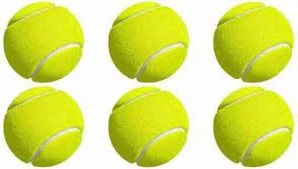“What is the diameter of a tennis ball” Tennis is a globally popular sport, and one of the fundamental elements that make the game possible is the tennis ball.

While it may seem like a trivial detail, the diameter of a tennis ball is an important specification that affects gameplay, manufacturing, and even the sport’s regulations. Understanding the diameter of a tennis ball involves looking at the standards set by governing bodies, the manufacturing process, and the impact of this measurement on the game itself.
Official Specifications
The diameter of a tennis ball is not arbitrarily decided. It is governed by official bodies such as the International Tennis Federation (ITF). According to the ITF, a regulation tennis ball must have a diameter ranging between 6.54 cm (2.57 inches) and 6.86 cm (2.70 inches).
This precise specification ensures consistency and fairness in the game, as variations outside this range could significantly alter the ball’s performance.
Why Diameter Matters
The diameter of a tennis ball plays a crucial role in its aerodynamic properties. A ball that is too large or too small would behave differently in flight, affecting the game’s dynamics.
A smaller diameter would mean less air resistance and potentially faster travel through the air, while a larger diameter would increase air resistance, slowing the ball down. Both scenarios, what is the diameter of a tennis ball could disrupt the balance of play, giving an unfair advantage to certain players or play styles.
Manufacturing Consistency
Producing tennis balls within the specified diameter range requires precision. The manufacturing process involves several steps to ensure that each ball meets the required standards.
This process typically includes what is the diameter of a tennis ball molding the rubber core, applying the felt covering, and subjecting the balls to rigorous testing. Even slight deviations in diameter can lead to a batch of balls being rejected.
The Impact on Players
For professional tennis players, even the smallest details matter. The feel of the ball, its bounce, and how it reacts to different shots are all influenced by its diameter. Players often develop a preference for certain types of balls, which can be a critical factor in their performance.
For instance, what is the diameter of a tennis ball a player who relies on a fast-paced game might prefer balls at the smaller end of the diameter spectrum, while a player who emphasizes spin and control might favor slightly larger balls.
What is the diameter of a tennis ball

Historical Changes
The standards for tennis balls have evolved over time. In the early days of the sport, there was less regulation, and balls varied widely in size and weight. As the sport became more organized and competitive, the need for standardization became clear.
The current diameter specifications were established to create a level playing field and have remained relatively stable for decades.
Technological Advances
Advancements in technology have also played a role in maintaining the consistency of tennis ball diameters. Modern manufacturing techniques allow for greater precision and quality control. High-tech machinery can measure what is the diameter of a tennis ball diameter of each ball with incredible accuracy, ensuring that only those within the specified range make it to the market.
Environmental Considerations
In recent years, there has been a growing awareness of the environmental impact of tennis ball production. The materials used, including the rubber core and the felt covering, have traditionally been sourced and manufactured in ways that are not environmentally friendly.
Efforts are being made to develop more sustainable manufacturing processes and materials, which could also affect the specifications of future tennis balls, including their diameter.
Fun Facts and Trivia
Number of Balls: In a professional tennis match, balls are changed every nine games to ensure they remain within the ideal performance range. This underscores the importance of maintaining consistent diameter and quality.
Recycling: Millions of tennis balls are produced each year, and many are discarded after use. Programs have been established to recycle old tennis balls, transforming them into various products, including flooring for sports facilities.
Pressureless Balls: Unlike traditional pressurized tennis balls, pressureless ,What is the diameter of a tennis ball rely on their material properties rather than internal pressure to maintain bounce. These balls typically have a longer lifespan but can feel different to play with.